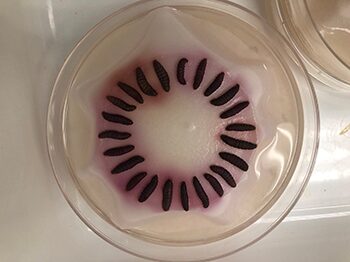AC learners research innovative solutions for biological pest control
Posted on Monday, April 10th, 2023
As part of sustainable, integrated pest management initiatives, learners in the Biotechnology – Advanced program are researching safe and effective alternatives to conventional chemical pesticides in the form of microscopic roundworms known as nematodes. By working with DNA fingerprinting, third-year students Dara Palmer and Autumn Henry are creating diagnostic profiles to identify different nematode species. They will debut their research findings in the upcoming RE/ACTION Showcase on April 14.
Nematodes are roundworms that exist naturally in nearly every ecosystem worldwide. As part of their life cycle, nematode larvae enter into a pest insect through naturally occurring openings, then release bacteria and mature rapidly, thus killing the host insect. In this study, wax moth juvenile caterpillars are used as this moth species acts as the model system to efficiently assist in the nematode life cycle. As a form of pest control, nematodes can be used for many insect pests affecting ecosystems from home gardens to commercial agriculture.
“Say you’re having a problem with insects on your houseplants. You would put the nematodes – perhaps in a spray or gel format – on your plants and they will go and find an insect to essentially grow in. But as they’re growing inside of it, they’re going to kill it as well. And they can live in the soil safely because that’s their natural habitat,” said Palmer.
The nematodes used in this study are not visible to the naked eye and require a microscope to observe. Due to their small size, molecular DNA fingerprinting diagnostics are required to identify species and determine how best to store them for commercial packaging and quality control.
“We use a kind of DNA fingerprinting to find differences between the species because you can’t look at a nematode and tell the difference between them,” said Palmer. “The main biological control we looked at was temperature to see what their optimal storage temperature is.”
The temperature control experiments determine the optimal storage temperature according to the nematode species. This data will then be used by suppliers to develop commercial packaging for the consumer market. This packaging could come in the form of sponge, gel, foam, or spray, depending on further research. Nematodes are already available for purchase in well-known retailers like Canadian Tire, Costco, and Amazon.
From a regulatory standpoint, nematodes are naturally occurring and not seen as a commodity pesticide by the government. Charles Nasmith, the students’ supervising professor, notes how conducting biological control research is much safer with nematodes than with chemical pesticides, as there is no interaction between the nematodes and humans or animals.
“Biological control of insects is one of numerous tools used in integrated pest management (IPM). IPM strategies help reduce the reliance on
dangerous chemical insecticides. These strategies include proper planting, spacing, soil, etc.,” he said. “These biological controls require that the user has knowledge of natural systems in a very focused way. Knowledge of natural systems, like these biological controls, promotes sustainable initiatives on and off campus.”
While chemical pesticides have been historically simple to produce and distribute, shifting public sentiment towards environmental concerns and natural alternatives have led to a resurgence in biological pest control research.
“It may be an easier route to use chemical pesticides over biological controls because with the latter, you have to know more about them to use them effectively,” said Henry. “However, even though biological pest controls require more research, that might be because they are the better solution.”
Palmer and Henry will be in attendance to discuss their project at the upcoming RE/ACTION Showcase on April 14 from 10 a.m. to 2 p.m. at the DARE District (C Building) on the Ottawa Campus. This will be the first showcase in three years to take place in-person. Click here to register.

